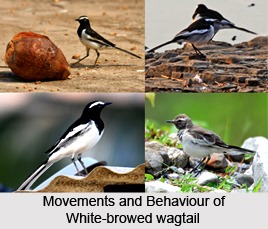 White-Browed Wagtail or Large Pied Wagtail is an Indian Bird that bears a scientific name "Motacilla maderaspatensis" found in Indian states like West Bengal, Punjab, Bihar, Chhattisgarh, and Jharkhand.
White-Browed Wagtail or Large Pied Wagtail is an Indian Bird that bears a scientific name "Motacilla maderaspatensis" found in Indian states like West Bengal, Punjab, Bihar, Chhattisgarh, and Jharkhand.
Category of White-Browed Wagtail
White-Browed Wagtail is a medium-sized bird and is the largest member of the wagtail family.
Structure of White-Browed Wagtail
White-Browed Wagtails are conspicuously patterned with black above and white below, a prominent white brow, shoulder stripe and outer tail feathers. They are common in small water bodies and have adapted to urban environments where they often nest on roof tops. The specific name is derived from the city of Chennai.
Size of White-Browed Wagtail
White-Browed Wagtail is the largest species of wagtail at 21 cm length. It is a slender bird, with the characteristic long, constantly wagging tail of its genus. It has black upperparts, head and breast, with a white supercilium and large white wing bar. Unlike White Wagtails it never has white on the forehead. The rest of the under parts are white. The female has the black less intense than in the male. Juveniles are like the females brown-grey where the adult is black.
Habitat of White-Browed Wagtail
White-Browed Wagtail is a resident breeder in India and is endemic to the Indian subcontinent. It is found south of the Himalayan Mountain Range, east of the Indus system and to the west of Bangladesh. It is rare in the higher altitude regions but has been seen in Ladakh on the edge of the Tibetan plateau. In most of India it is found below 1000 m but in southern India it goes up into the hills up to 2200 m. It is very rare in the Indus valley area. It is absent from the Sind region of Pakistan. It is found in open freshwater wetland habitats. It is one of the few Motacilla wagtails that has adapted well to urban habitats and is often found perched on overhead water storages in residential buildings.
Breeding Season of White-Browed Wagtail
The breeding season of White-Browed Wagtail is from March to October. In southern India, the nesting season begins when river levels drop and continue until the Monsoon rains. In courtship, the male shoots into the air with a single wing beat, sings and glides with dangling legs and puffed feathers. On settling, the tail of the male is raised high and wings held up over the back and the tip is quivered stiffly while he steps around the female. The female responds by crouching and shivering the wings as if begging for food.
Nests of White-Browed Wagtail
White-Browed Wagtail builds its cup-shaped nest placed on the ground or rocks in a hole, ledge or mud bank and is always located close to water. Artificial structures such as bridges and roof tops are also used.
Feeding of White-Browed Wagtail
White-Browed Wagtail is insectivorous. Nestlings were mainly fed orthopterans, caterpillars and spiders. Stayphylinid beetles and pentatomid bugs have also been recorded in their diet. In captivity they have been recorded feeding on annelids. They have adapted to urban environments where water may be found mainly on rooftops as overflow from storage tanks.



















